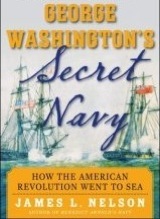George Washington’s Secret Navy book review
 George Washington’s Secret Navy: How the American Revolution Went to Sea. By James L. Nelson. McGraw-Hill, 2008. 374 pgs. Hardcover, $26.95.
George Washington’s Secret Navy: How the American Revolution Went to Sea. By James L. Nelson. McGraw-Hill, 2008. 374 pgs. Hardcover, $26.95.
Washington deliberately kept the Continental Congress in the dark about much of his planning.
Think of the seafaring forces that have squared off against the massive military might of the Royal British Navy. Not many of them came out of the fight in the same condition as they went in—if they came back at all. James L. Nelson’s new book, George Washington’s Secret Navy: How the American Revolution Went to Sea, describes just such a series of encounters between His Majesty’s fleet and a fledgling, ramshackle naval flotilla hastily created by a young George Washington during the early days of the colonials’ fight for independence. Incredibly, the upstarts held their own against the master of the waves.
{default}Washington had earned an enviable reputation as a soldier on the North American continent prior to the start of the Revolution, before he was given command of the new Continental Army. But his martial skills had been developed through combat against the French and Indians on the heavily forested frontier. What he knew about naval combat was practically nil.
When he arrived at Boston to officially begin his duties, he quickly grasped the sad state of affairs regarding supplies and equipment for his Army. In contrast, the British had a disciplined, well-trained force and well-established supply sources. British naval power held sway over the colonial coast and protected the Redcoats’ vital transatlantic supply line. As Washington asked questions and sought answers from the almost impotent Continental Congress, he craftily and secretly put into motion a plan he hoped would help balance out the vast disparity between his forces and those of the British.
George Washington’s Secret Navy explores a scant few months—less than a year—during which Washington and a handful of early America’s greatest advocates for independence successfully put together a fleet of ships and sailors to stand against the vaunted British Navy.
If the comparison between Colonial and British land forces weren’t capacious enough, it was made even greater when comparing the Royal Navy to the meager number of boats under colonial ownership. In one respect, the colonies did have the upper hand, if only in the amount of fishing boats in operation along their coasts, and it is from them that Washington began to build an armed naval force. Longboats, sloops, and schooners were the most abundant boats available, and were added piecemeal, by direct command and dire necessity, to Washington’s small and as yet unofficial navy.
[continued on next page]
Pages: 1 2


I wrote George Washington’s New England Fleet (1969) and The Army’s Navy in a Year of Revolution (1976). I lived in Beverly, MA when I wrote these two books and others related to Washington’s New England and NY, ME fleet activity, eh?> I’m wondering if you used my books as sources. I’ll get yours to see. And, I’m wondering what inspired you to write this book. Thanks.
Donald W. Beattie, Ph.D.
President, Mackintosh Associates
245 Main Street
Winthrop, ME 04364